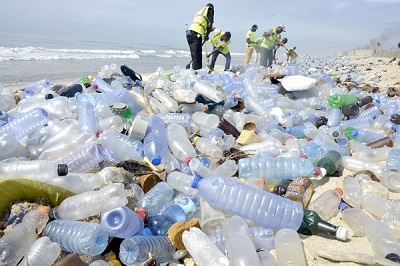Plastic pollution causes harm

Plastic pollution has quickly become one of the world’s most serious environmental problems. This problem is evident in developing countries where the production rate of plastic has outpaced their ability to recycle or how to efficiently dispose of them.
Widespread littering and indiscriminate dumping of plastic waste are increasingly becoming a threat to our existence as plastics pollute the land, water and air. The hazardous impacts of plastics to the environment, human health, marine life and sustainable development cannot be overlooked.
Plastics have become necessary in our daily lives because their benefits are undeniable across sectors, from households, medicine, clothing, agriculture, transport etc. However, plastic pollution has now become an albatross.
Experts say that most plastics are made from fossils, that is, petroleum, and as Ghana is discovering large quantities of oil by the day, it means in a global and circular economy, plastics will reign for some time, if not for a long time.
Single use
A lot of single-use plastics, such as drinking straws, shopping bags, plastic drinking containers, plastic bottle caps, food packaging (Styrofoam, which contains styrene and benzene), among others, have been and are indiscriminately disposed of in an unfriendly and unsightly manner.
This affects our environment and obviously our health. All plastics contain toxic additives, which are used to make them flexible, flame-retardant, or meet other performance demands. The cocktail of these toxic additives that go into making plastics enter the environment when plastics break down.
In the ocean, plastics quickly become microplastics, attracting toxic industrial chemical hitch-hikers. These are incorporated into the food chain and fishes eat them, creating one pathway for toxic microplastic accumulation in larger animals, like us, when we consume fish.
Bio-degradable
Most plastics do not decompose or biodegrade except the bio-based ones. Plastics will remain in the environment, especially the soil and water bodies, for years and even at the end of their decomposition or biodegradation (if they are biodegradable) they are more dangerous.
According to experts, when plastics enter the environment and oceans, they break into minute particles called microplastics and or nanoplastics.
These microplastics enter the food chain and finally end up in the foods we eat. Our bodies do not become the resting places for them, rather they get into the biochemical processes in the body by imitating the natural chemicals (hormones) produced.
Once in the body, these substances can lead to the malfunctioning of the target organs ending up in nervous systems, lungs and reproductive organs. Humans are exposed to a large variety of toxic chemicals and microplastics through inhalation, ingestion, and direct skin contact, all along the plastic life cycle
Consequences
Single use plastics choke drains and create breeding sites for mosquitoes, or when left on dumpsites, where animals sometimes mistake them for food and get choke to death. They are burnt openly causing smoke containing hazardous substances like furan and dioxins, which are cancer causing agents.
Again, plastic waste that ends up in landfills contributes to the contamination of groundwater, land and air pollution. Undisposed plastics can block our drains and lead to flooding.
The stagnant water from pollution-induced flooding also facilitates the outbreak of waterborne diseases like malaria and cholera among vulnerable people living in highly polluted areas.
I believe that, if current practices and attitudes towards the production, handling and disposal of plastics are not modified, then we are heading towards a non-achievement of the Sustainable Development Goals (SDGs) and the consequences would be more graver than we have today, leaving a heavy burden for the future generations.
The way forward
To reduce the menace of plastic waste is to reduce its production, use and to institute better disposal mechanisms, which must come from research and development to fill existing and future knowledge gaps.
Solutions must be built on transparency, participation and the right to remedy. Transparency is required to identify the nature and breadth of exposure to toxic material, as well as assess possible health and environmental impacts of technologies touted as “solutions,” such as incineration and plastic-to-fuel technologies to find alternatives which would be environmentally friendly.
At every stage of its lifecycle, plastic poses distinct risks to human health, arising from both exposure to plastic particles themselves and associated chemicals.
Addressing plastic pollution requires adapting and adopting legal frameworks to ensure access to information regarding the petrochemical substances in products and processes.
A broader stakeholder consultation is a must to find possible pathways to the legislation in decision-making about plastic-related risks. Let every right – thinking Ghanaian help to accelerate the reduction of plastic waste and pollution in the country. It is our collective responsibility.
By Ernestina Kwakye
The writer, Ernestina Kwakye is a student of the Ghana Institute of Journalism (GIJ) Writer’s email: frimpomaat75@gmail.com












